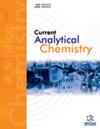利用毛细管电泳和安培检测法同时测定汗液中的甘油和碳水化合物
IF 1.7
4区 化学
Q3 CHEMISTRY, ANALYTICAL
引用次数: 0
摘要
背景:甘油、蔗糖、乳糖、葡萄糖和果糖是人体汗液中重要的生物标志物,因为它们的含量可以反映生理状态和健康状况。测定汗液中甘油、蔗糖、乳糖、葡萄糖和果糖的含量对健康监测、疾病诊断、体育训练等具有重要意义。目的:本研究旨在开发一种基于毛细管电泳和安培检测的方法,用于同时测定汗液中的甘油和碳水化合物。目标:采用毛细管电泳和安培检测法同时测定汗液中的甘油和碳水化合物:开发了一种基于吸管吸头检测电极和微型注射器的毛细管电泳方法,用于同时测定汗液样品中的甘油、蔗糖、乳糖、葡萄糖和果糖:将在 75 mM NaOH 水溶液的背景电解质中稀释的汗液样品通过移液管吸头式微注射器以电动方式导入分离毛细管。甘油、蔗糖、乳糖、葡萄糖和果糖通过毛细管电泳结合移液管吸头铜电极进行测定。结果:在直流电压为 12 kV 时,在含有 75 mM NaOH 水溶液的 40 cm 长熔融石英毛细管中,五种分析物的毛细管电泳分离可在 11 分钟内完成。电流与浓度之间呈线性关系,在检测电位为 0.65 V 时,检测限为 0.21 至 0.72 µM。对汗液样本中的甘油、蔗糖、乳糖、葡萄糖和果糖进行了正面识别和精确测量。结论该方法成功地应用于同时测定汗液样本中的甘油和碳水化合物,测定结果令人满意。该方法可广泛应用于临床诊断、健康监测、药物和食品分析等领域。本文章由计算机程序翻译,如有差异,请以英文原文为准。
Simultaneous Determination of Glycerol and Carbohydrates in Sweat by Capillary Electrophoresis with Amperometric Detection
Background: Glycerol, sucrose, lactose, glucose, and fructose are important biomarkers in human sweat because their contents can reflect physiological status and health conditions. It is of high importance to determine them in sweat for health monitoring, disease diagnosis, physical training, etc. Aim: The aim of this work is to develop a method based on capillary electrophoresis and amperometric detection for the simultaneous determination of glycerol and carbohydrates in sweat. Objective: A capillary electrophoretic method based on pipette-tip-based detection electrodes and micro-injectors was developed for the simultaneous determination of glycerol, sucrose, lactose, glucose, and fructose in sweat samples Method: Sweat samples diluted in the background electrolyte of 75 mM NaOH aqueous solution were electrokinetically introduced into a piece of separation capillary via pipette tip-based microinjectors. Glycerol, sucrose, lactose, glucose, and fructose were determined by capillary electrophoresis in combination with a pipette-tip-based copper electrode. Results: At a DC voltage of 12 kV, the capillary electrophoretic separation of the five analytes could be achieved in less than 11 min in a piece of 40 cm long fused silica capillary containing 75 mM NaOH aqueous solution. Linearity was observed between the currents and concentrations, with the limits of detection ranging from 0.21 to 0.72 µM at a detection potential of 0.65 V. Glycerol, sucrose, lactose, glucose, and fructose in sweat samples were positively identified and accurately measured. Conclusion: The method was successfully applied in the simultaneous determination of glycerol and carbohydrates in sweat samples with satisfactory assay results. It will find a wide range of applications in clinical diagnosis, health monitoring, and drug and food analysis.
求助全文
通过发布文献求助,成功后即可免费获取论文全文。
去求助
来源期刊

Current Analytical Chemistry
化学-分析化学
CiteScore
4.10
自引率
0.00%
发文量
90
审稿时长
9 months
期刊介绍:
Current Analytical Chemistry publishes full-length/mini reviews and original research articles on the most recent advances in analytical chemistry. All aspects of the field are represented, including analytical methodology, techniques, and instrumentation in both fundamental and applied research topics of interest to the broad readership of the journal. Current Analytical Chemistry strives to serve as an authoritative source of information in analytical chemistry and in related applications such as biochemical analysis, pharmaceutical research, quantitative biological imaging, novel sensors, and nanotechnology.
 求助内容:
求助内容: 应助结果提醒方式:
应助结果提醒方式:


